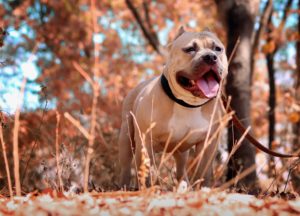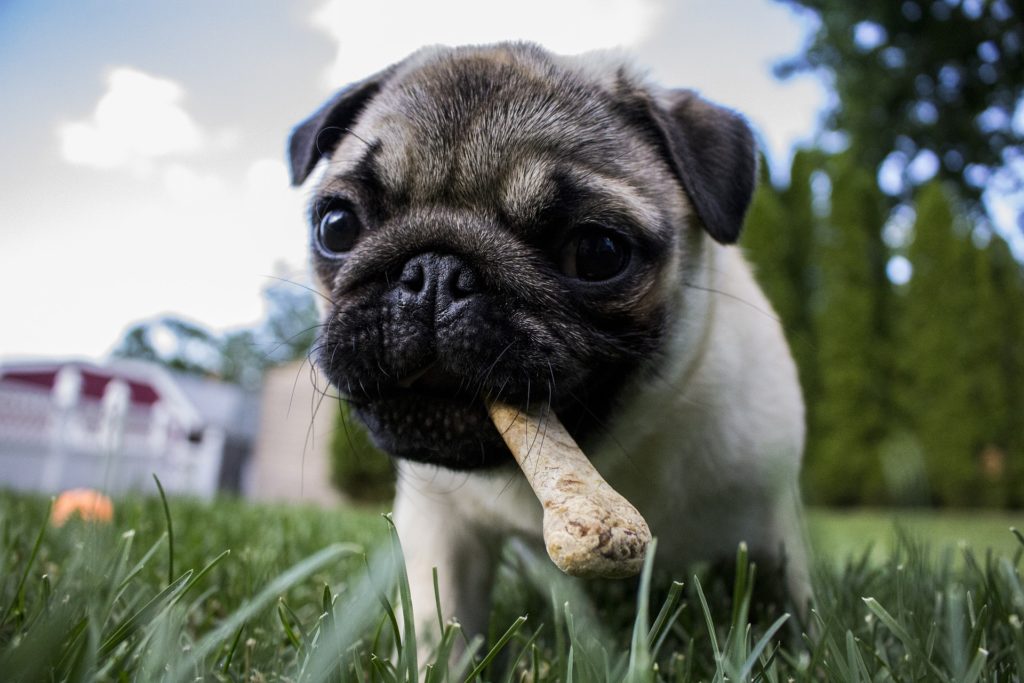From small puppies to adult dogs, most pet parents will agree upon one thing: dogs love to chew! A go-to treat that’s been around for many decades is rawhide, a widely used product that satisfies a canine’s natural urge to chew. Since they are relatively cheap and available in most pet shops, rawhides can be a good chew option for certain dogs – particularly pooches who actually chew the rawhide versus biting off and swallowing chunks of it. In the former case, happy chompers will benefit from teeth-cleaning and chewing satisfaction.
However, in the case of canine inhalers, rawhide can cause serious problems, as the ingested bits may become lodged inside the windpipe, resulting in choking incidents; in other cases, large pieces may wind up in a dog’s stomach, leading to digestive obstructions. Because of these possible threats, you may be wondering, “Is rawhide dangerous for dogs?” This article will explore the pros and cons of rawhide for dogs, other treats and chews, as well as how to determine the best type of chews for individual dogs based on various factors.
What Is Rawhide Made Of?
Using the inner layer of cow or horse hides, rawhides are first cleaned and then cut up or ground during manufacturing, depending on the final product. Next, they are pressed into dog chews of varying sizes and shapes. Some companies add beef, liver or chicken flavorings to rawhide treats and chews in order to make them more appetizing to dogs.
 Recently, many pet parents have expressed a growing concern regarding the ingredients found in dog food and treats, including rawhide chews. As a result, some rawhide manufacturers are marketing their products using descriptives such as ‘natural’, ‘organic’ and ‘digestible’, but it’s important to read ingredients and labels carefully before choosing dog chews, as they’re not all created equally.
Recently, many pet parents have expressed a growing concern regarding the ingredients found in dog food and treats, including rawhide chews. As a result, some rawhide manufacturers are marketing their products using descriptives such as ‘natural’, ‘organic’ and ‘digestible’, but it’s important to read ingredients and labels carefully before choosing dog chews, as they’re not all created equally.
While all rawhide chews are made from dried animal hide and may start off ‘naturally’, what happens next usually determines the quality and safety of the finished product. Specifically, it’s where the rawhides originate from that consumers must research – rawhide chew treats made in the United States may be pricier, but they are well worth it when it comes to a beloved pet’s health and well-being.
In essence, most rawhide chews are fabricated from the leather industry’s leftover scraps. Rawhide chews that are imported typically have an extra dose of chemicals. In countries outside of the U.S., hides are removed from the slaughterhouse floors and treated in a high-salt brine or chemical bath, which helps ‘preserve’ the product from decaying during transport.
During the processing phase, hides are first soaked in an ash-lye solution to remove the hair and fat from the skin. Next, it is often ‘cleaned’ with water, bleach and/or hydrogen peroxide. In some countries arsenic (and even formaldehyde) is used in the treatment process, although it is banned in the U.S. The hides are then refrigerated until they are processed to keep them fresh and prevent spoilage. Finally, they are either left natural or smoked, and artificial flavors are frequently added to make the rawhide chews more appealing to dogs.
While the United States uses fairly stringent manufacturing processes in comparison to other countries, the FDA does not regulate the manufacture of rawhides in the U.S. Because of the inconsistencies in quality, treatment, and ingredients found in imported rawhide, many vets recommend rawhide products made exclusively in the United States. Additionally, some experts advise pet owners to rinse rawhide treats first in water before administering to dogs.
Did You Know…
Rawhides can also be contaminated with salmonella – the same holds true for other animal part-based treats, such as pig ears, cow ears, hooves, and other similar items. Salmonella is known to affect younger pups, as well as dogs with compromised health. However, humans in the household are actually more at risk of infection than dogs – for example, seniors, young children, pregnant women, and anyone with a compromised immune system is at risk. The best precaution is prevention and being proactive: don’t allow children to play with or chew on rawhides, and be sure to wash hands thoroughly after giving dogs a treat or handling the chews in general.
How To Make Rawhide Chews Safer For Dogs: A Helpful Guide
 For pet owners who opt for rawhide as their go-to dog treat, there are a number of precautions that can be taken to make them as safe as possible. Because no dog treat is 100% ‘safe’, it is up to people to handle them with care – minimize the risk of exposure to contaminants and wash hands thoroughly with antibacterial soap after handling rawhide treats and chews. In addition, make sure anyone in the household with compromised immune systems avoids contact with any rawhide products.
For pet owners who opt for rawhide as their go-to dog treat, there are a number of precautions that can be taken to make them as safe as possible. Because no dog treat is 100% ‘safe’, it is up to people to handle them with care – minimize the risk of exposure to contaminants and wash hands thoroughly with antibacterial soap after handling rawhide treats and chews. In addition, make sure anyone in the household with compromised immune systems avoids contact with any rawhide products.
Keep the following guidelines in mind when administering rawhide chews to dogs:
- Keep him separated: When administering rawhide chews, separate your dog from other household pets so he can relax while chewing. A dog is less likely to ‘inhale’ large chunks of the chew whole – this is particularly true of dogs who display territorial behavior around food or in general.
- Provide a variety of rawhide treats: Once the vet has recommended safe rawhide chews, see which one he likes and which ones he handles the best. Take note: is he swallowing or gulping big bites? Is he gagging? Is your dog choking? If so, take the treat away immediately and discuss with the vet’s office to determine what other types of rawhide, dog chews, treat or toys might be a better option for the family pooch.
- Speak with a veterinarian: Pet owners should always speak with their vet to find out how much is safe for their dog, as well as what specific brand is best for him. Generally speaking, smaller dogs should be given fewer chews. Introduce one chew at a time to see how your dog reacts.
- Watch the size: After a while, a dog will whittle a rawhide chew down to a nub, and this is when it can pose a choking hazard. Be sure to keep a watchful eye over a dog’s rawhide treat – once it’s gotten too small, take it away; if he protests, ask him to sit and offer another toy or treat to replace the chew.
In addition, be sure to watch for signs of bacterial contamination, gastric irritation, or a blockage. Call your vet immediately if a dog shows symptoms including:
- Diarrhea (with or without blood)
- Fever
- Gagging or choking
- Lethargy or lack of energy
- Loss of appetite
- Weight loss
- Repeated swallowing
- Signs of pain
- Vomiting
The Pros & Cons of Rawhide Treats
While rawhide bones, chews and treats may or may not be suitable for every dog, it is ultimately up to the pet parent to decide whether or not it’s the best treat for their pooch. In this section, we’ll review the advantages and the pitfalls of this classic dog chew:
Pros:
- Satisfies Canine Chewing Urges: Rawhide chews & treats satisfy a dog’s natural instinct to chew
- Dental Benefits: When administered properly, rawhide products are excellent at cleaning a dog’s teeth by removing plaque and tartar build-up
- Affordable Dog Treats: Rawhide dog treats are typically inexpensive, making them an affordable option for many dog owners
Cons:
- Harmful Chemicals: Some rawhide chews are treated with harmful chemicals and additives, so be sure to shop carefully and read the labels before purchasing
- Poor Quality: Low-quality rawhides have been reported to break a dog’s teeth, causing him pain (and expensive vet bills for the owner)
- Artificial Flavors & Digestive Issues: Artificially-flavored rawhide treats and bones may cause digestive issues (including vomiting, diarrhea and allergic reactions) for dogs with allergies and sensitivities
Hazards:
- Buying the wrong size is dangerous: If the owner does not purchase the appropriately-sized rawhide for the dog (based on size, breed and chewing style), the chew can pose a serious choking hazard
- Always watch dogs chewing rawhide to prevent accidents: If the owner does not watch their dog carefully while he is chewing the rawhide, large chunks may be swallowed whole – this behavior is most common among dogs who are inhalers, gulpers, and/or destructive/aggressive chewers. Because rawhide is indigestible, it can lead to choking, gastric obstruction (which may require surgery), serious illness, or in worst-case scenarios, death – so always monitor pets carefully when administering any type of chew toy or bone
Which Dogs Should Avoid Rawhide Bones?
When it comes to selecting a safe dog chew, the choices may seem overwhelming. While some people may sing the praises of rawhide, other pet owners may strongly disagree due to a negative personal experience, or simply based on bad online reviews. At the end of the  day, pet parents ultimately must decide if their dog can handle a chew safely – and if they are willing to commit to watching their pet carefully whenever feeding them a rawhide treat. Although these treats have many benefits – including the fact that they’re long-lasting, provide a great distraction to dogs, and even promote good dental health – whether or not it is best for one’s pooch really depends upon a few key factors as illustrated below:
day, pet parents ultimately must decide if their dog can handle a chew safely – and if they are willing to commit to watching their pet carefully whenever feeding them a rawhide treat. Although these treats have many benefits – including the fact that they’re long-lasting, provide a great distraction to dogs, and even promote good dental health – whether or not it is best for one’s pooch really depends upon a few key factors as illustrated below:
- Chewing style: As mentioned previously, each dog has his own chewing style – some dogs are gentle nibblers, while others destroy whatever they come into contact with – and then there are those pooches who want to swallow everything. Therefore, the type of treat is highly dependent on a dog’s individual way of chewing. If his chewing/eating habits and behaviors put him at risk for choking or injury, pet parents may want to consider ‘safer’ digestible alternatives to satisfy his chewing urges while maintaining his dental regimen.
- Breed: Certain breeds may be more aggressive or ‘heavier’ chewers, so dog owners should take note of their four legged friend’s habits and speak with a vet to determine the best type of rawhide or other chew suited to his needs.
- Age: A dog’s age also plays a role in his chewing style, too – young pups and geriatric dogs have a much softer palate than their adult counterparts. Chews and toys should, therefore, correspond to a dog’s age-appropriate requirements.
- Health History: For dogs with any type of health issues – be it a preexisting condition, disease, allergies, canine obesity, dog digestive problems or other troubles – be sure to discuss with his vet when considering chew treats and other dietary options. Additionally, if a dog shows signs of anxiety, boredom or other behavioral issues, a vet or licensed dog trainer may recommend specific toys (such as puzzle toys and chews) that may challenge him, help to ease his canine anxiety, and so on.
Keeping all of this information in mind, it’s pretty safe to say a dog’s chewing style will adapt and change over the course of his lifetime, and what is considered a ‘safe’ treat at one point of his existence may be very different at another phase. Therefore, it’s essential to stay abreast of his personal habits and changing needs in order to provide not only the safest chews, but the best care possible as a loving pet parent.
Our all-natural hemp dog treats are not only tasty but also provide potential CBD benefits to your dog. Try our unique hemp CBD treats for dogs today!
Sources Cited:
- Stebbins, Nicole. “Rawhide Bones: The Good, The Bad & The Downright Dangerous.” Canine Journal.com, March 29, 2017, https://www.caninejournal.com/rawhide-bones/. Accessed April 18, 2019.
- “Rawhide: Good or Bad for Your Dog?” WebMD.com, (no publish date), https://pets.webmd.com/dogs/rawhide-good-or-bad-for-your-dog#1. Accessed April 18, 2019.
- Burke, Anna. “Are Rawhide Chews Dangerous for Your Dog?” American Kennel Club (AKC.org), October 4, 2017, https://www.akc.org/expert-advice/health/are-rawhide-chews-dangerous-for-dog/. Accessed April 18, 2019.
- Becker, Dr. Marty, DVM. “Is It Safe to Give My Dog a Rawhide?” VetSTREET.com, January 30, 2017, http://www.vetstreet.com/dr-marty-becker/is-it-safe-to-give-my-dog-a-rawhide?page=2. Accessed April 18, 2019.




